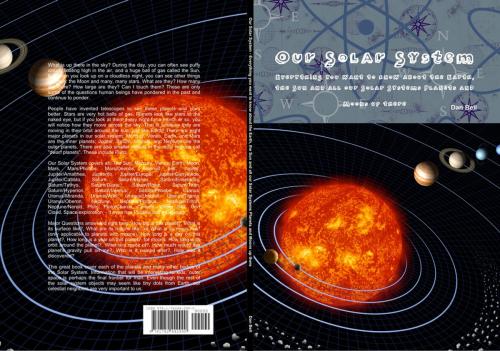Our Solar System - Everything you want to know about the Earth, the Sun and all our Solar Systems Planets and Moons up there
Kids, Technology, Aeronautics, Astronautics & Space Science, Nonfiction, Reference & Language, Reference| Author: | Dan Bell | ISBN: | 9781486432257 |
| Publisher: | Emereo Publishing | Publication: | October 24, 2012 |
| Imprint: | Emereo Publishing | Language: | English |
| Author: | Dan Bell |
| ISBN: | 9781486432257 |
| Publisher: | Emereo Publishing |
| Publication: | October 24, 2012 |
| Imprint: | Emereo Publishing |
| Language: | English |
People have invented telescopes to see these planets and stars better. Stars are very hot balls of gas. Planets look like stars to the naked eye, but if you look at them every night for a month or so, you will notice how they move across the sky. That is because they are moving in their orbit around the sun, just like Earth! There are eight major planets in our solar system: Mercury, Venus, Earth, and Mars are the inner planets; Jupiter, Saturn, Uranus, and Neptune are the outer planets. There are also smaller objects in the outer regions call "dwarf planets". These include Pluto.
Our Solar System covers all: The Sun, Mercury, Venus, Earth, Moon, Mars, Mars/Phobos, Mars/Deimos, Asteroid belt, Jupiter, Jupiter/Amalthea, Jupiter/Io, Jupiter/Europa, Jupiter/Ganymede, Jupiter/Callisto, Saturn, Saturn/Mimas, Saturn/Enceladus, Saturn/Tethys, Saturn/Dione, Saturn/Rhea, Saturn/Titan, Saturn/Hyperion, Saturn/Iapetus, Saturn/Phoebe, Uranus, Uranus/Miranda, Uranus/Ariel, Uranus/Umbriel, Uranus/Titania, Uranus/Oberon, Neptune, Neptune/Proteus, Neptune/Triton, Neptune/Nereid, Pluto, Pluto/Charon, Comets, Kuiper Belt, Oort Cloud, Space exploration - It even has Puzzles and a Glossary.
Major Questions answered right here: How big is this planet?, What is its surface like?, What are its moons like? or What is its moon like? (only applicable to planets with moons), How long is a day on this planet?, How long is a year on this planet?, for moons: How long is its orbit around the planet?, What is it made of?, How much would this planet's gravity pull on me?, Who is it named after?, How was it discovered?
This great book cover each of the planets and many other bodies of the Solar System. Information that will be interesting to kids: outer space is perhaps the final frontier for man. Even though the rest of the solar system objects may seem like tiny dots from Earth, our celestial neighbors are very important to us.
People have invented telescopes to see these planets and stars better. Stars are very hot balls of gas. Planets look like stars to the naked eye, but if you look at them every night for a month or so, you will notice how they move across the sky. That is because they are moving in their orbit around the sun, just like Earth! There are eight major planets in our solar system: Mercury, Venus, Earth, and Mars are the inner planets; Jupiter, Saturn, Uranus, and Neptune are the outer planets. There are also smaller objects in the outer regions call "dwarf planets". These include Pluto.
Our Solar System covers all: The Sun, Mercury, Venus, Earth, Moon, Mars, Mars/Phobos, Mars/Deimos, Asteroid belt, Jupiter, Jupiter/Amalthea, Jupiter/Io, Jupiter/Europa, Jupiter/Ganymede, Jupiter/Callisto, Saturn, Saturn/Mimas, Saturn/Enceladus, Saturn/Tethys, Saturn/Dione, Saturn/Rhea, Saturn/Titan, Saturn/Hyperion, Saturn/Iapetus, Saturn/Phoebe, Uranus, Uranus/Miranda, Uranus/Ariel, Uranus/Umbriel, Uranus/Titania, Uranus/Oberon, Neptune, Neptune/Proteus, Neptune/Triton, Neptune/Nereid, Pluto, Pluto/Charon, Comets, Kuiper Belt, Oort Cloud, Space exploration - It even has Puzzles and a Glossary.
Major Questions answered right here: How big is this planet?, What is its surface like?, What are its moons like? or What is its moon like? (only applicable to planets with moons), How long is a day on this planet?, How long is a year on this planet?, for moons: How long is its orbit around the planet?, What is it made of?, How much would this planet's gravity pull on me?, Who is it named after?, How was it discovered?
This great book cover each of the planets and many other bodies of the Solar System. Information that will be interesting to kids: outer space is perhaps the final frontier for man. Even though the rest of the solar system objects may seem like tiny dots from Earth, our celestial neighbors are very important to us.















